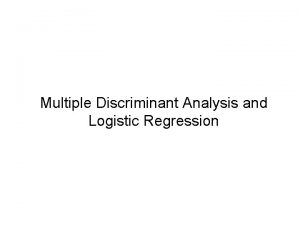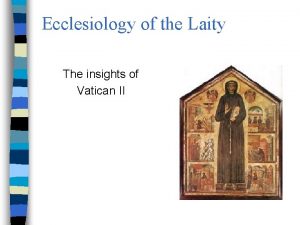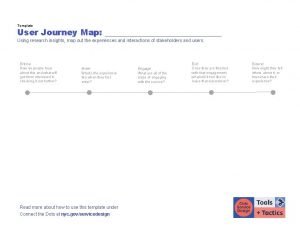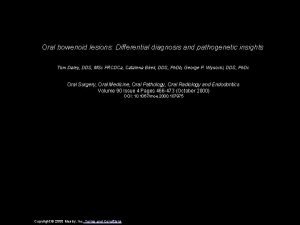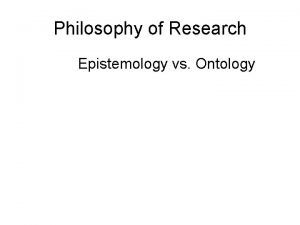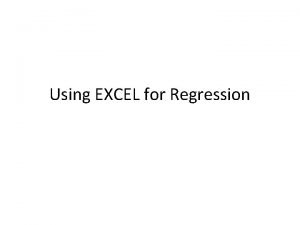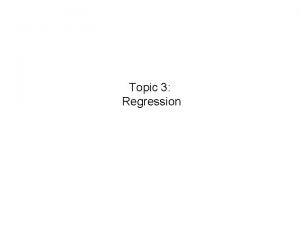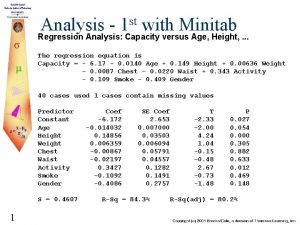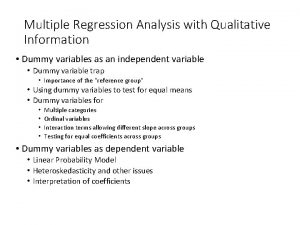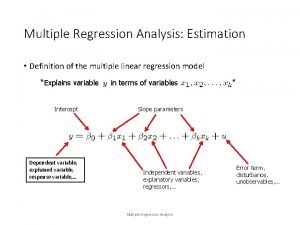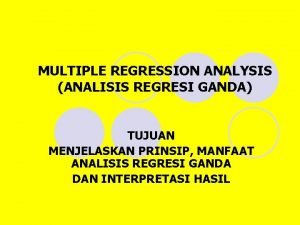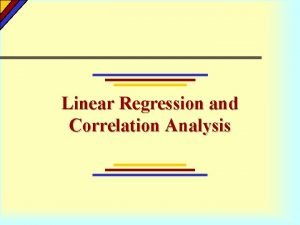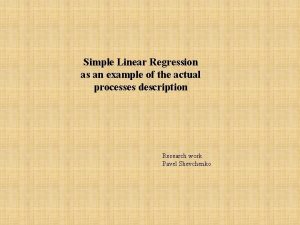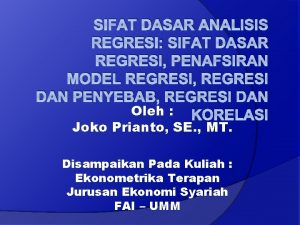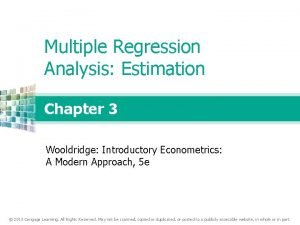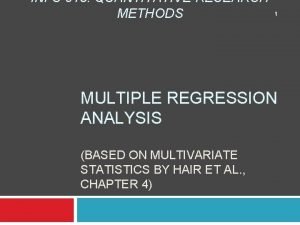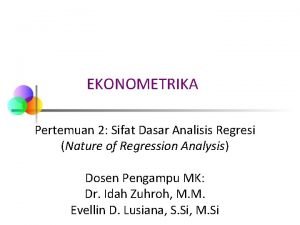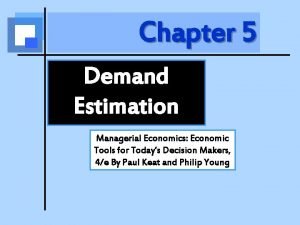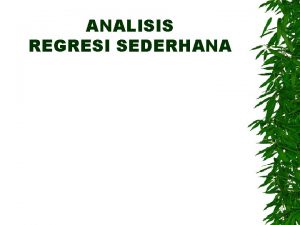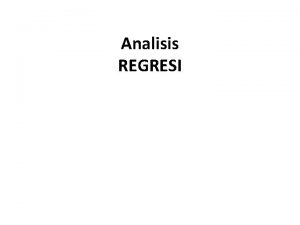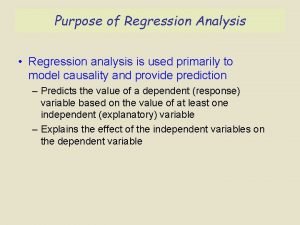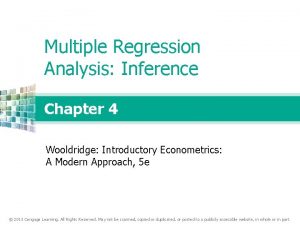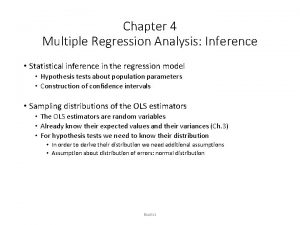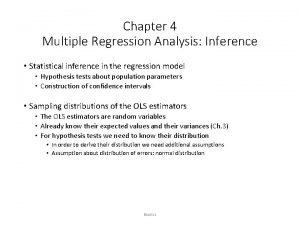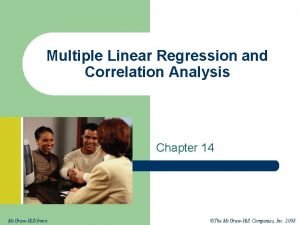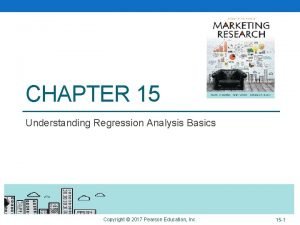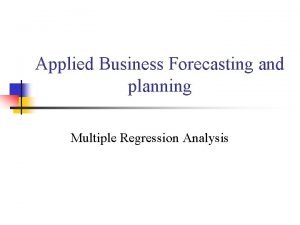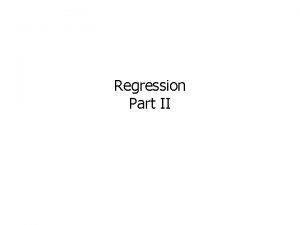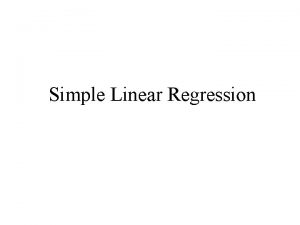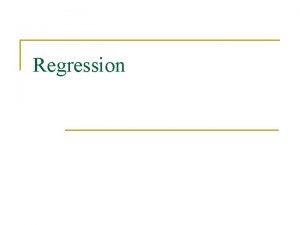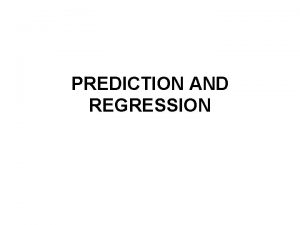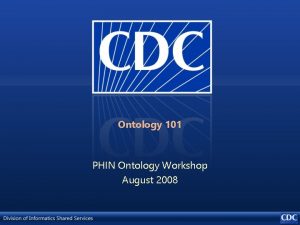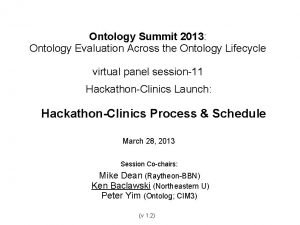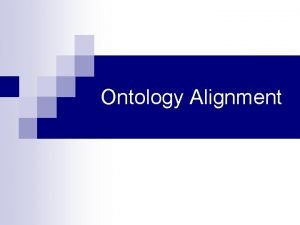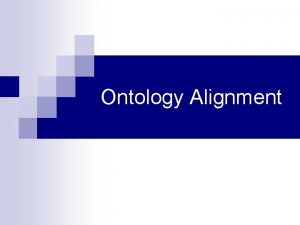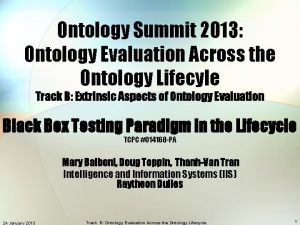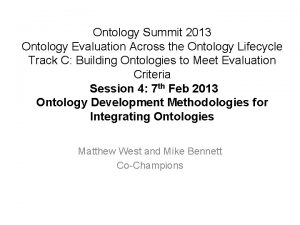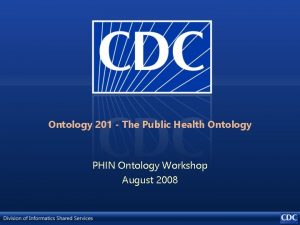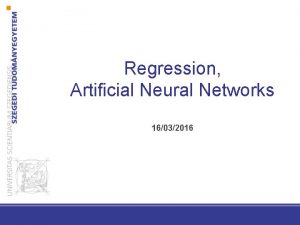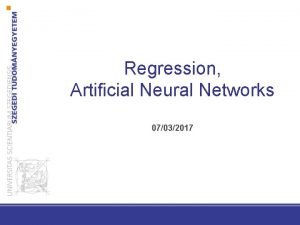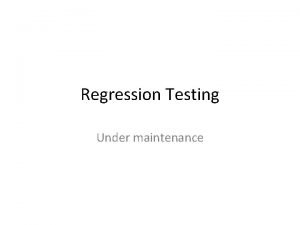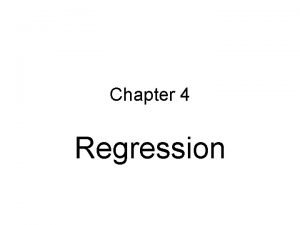Ontology Evolution and Regression Analysis Insights into Ontology










































- Slides: 42

Ontology Evolution and Regression Analysis Insights into Ontology Regression Testing Maria Copeland Rafael Goncalvez Robert Stevens Bijan Parsia Uli Sattler

Motivation Current studies of Ontology Evaluation tend to: • Focus on individual ontology versions • Focus on shifts in the gross statistics In either case we don’t get objective and systematic evaluations of the life span of the ontology

Our goal is to extract insightful and useful information out of all the existing versions of an ontology

Ontology Testing Challenge – How do we systematically identify test areas? – How do we systematically analyse change impacts to the ontology? How can we effectively minimise testing efforts and cost and still achieve adequate testing coverage

Software Testing

Software Regression Testing What is it? • It is a test activity to systematically re-test existing components after software changes • It test against current and updated requirements

Software Regression Testing Aspects • Testing at the functional requirements – Unit Level – System Level • Testing at the non-functional requirements

Software Regression Testing Plan • Defines testing criteria • Identifies test area or components • Test execution strategy • Test evaluation strategy • Updates test and other relevant documentation

Software Regression Testing Process Change Detection Impact Analysis Define Test Plan Build Test Suite Run Test Evaluate Results Report Results

Ontology Regression Testing?

Change Detection • Explicit Changes – Asserted logical and annotation axioms – Properties – Classes • Implicit Changes? – Subsumption changes – Entailment changes

Impact Analysis • Previous Version or all versions? – Intentional Difference analysis? – Justifications analysis? • Information Content? – Asserted content? – Entailed content? • Requirements Impact? – Functional and Non-functional? – Which ones do we test?

Define Test Plan • Test criteria? • Test area? Do we have test areas? • How can the test be systematically run? • Can results be interpreted?

Can we systematically: • Build test suites? • Run tests? • Evaluate results? • Re-run tests if necessary?

Manual vs. Automated Test Suites • Manually test cases – Check against a methodology – Eyeballing • Automated test cases – Satisfiability – Inconsistency

Manual vs. Automated Test Suites • Manually test cases – Time consuming – Subjective – Unsystematic • Automated test cases – Reasoner based – Limited in scope

Can we expand the range of automatic test suites?

YES By Analysing Ontology Dynamics

What are Ontology Dynamics? • Periods of growth, decline, and stability • Axioms presence • Types of axioms presence (e. g. continual, interrupted) • Sequence editing types and patterns

Axiom Life Span - We expect: Axioms with Constant Unchanged Presence αi O 1 Oi Ontology Versions

Axiom Life Span - We expect: Axioms that are Modified Split or Merge αi O 1 Oi Oi+n Ontology Versions

Axiom Life Span - We expect: Axioms that Enter and Leave the Ontology αi O 1 Oi Ontology Versions Oi+n

NCIt Ontology Dynamics

National Cancer Institute Thesaurus (NCIt) • The National Cancer Institute (NCI) is a U. S. government funded organisation for the research of causes, treatment, and prevention of cancer • The NCIt is an ontology written in the Web Ontology Language (OWL) which supports the development and maintenance of a controlled vocabulary about cancer research • Multiple publications about process, quality control, usage, and critiques • Publicly available monthly releases and concept change logs Rich source of ontology evolution data

NCIt Dynamics – Axioms Life Span Analysis Asserted Axioms Frequency Distribution 25000 10000 5000 0 11 2 87 79 103 16 24 98 10 74 28 34 29 9 31 27 14 99 81 33 20 25 77 80 47 49 18 63 66 54 73 70 51 39 91 44 95 86 41 61 90 35 60 85 68 94 40 37 67 89 102 100 Number of Asserted Axioms 20000 Frequency Distribution Frequency

NCIt Change Dynamics – Detailed View of Axiom Life Span Top Ten Frequency Distributions

NCIt Axiom Life Span: Axioms with Constant Unchanged Presence αi 6. 73% O 103 NCIt 2003 – 2012 103 Versions

NCIt Axiom Life Span: Axioms that Enter and Leave the Ontology αi O 1 Oi Oi+n NCIt 2003 – 2012 103 Versions

NCIt Axiom Life Span: Axioms with Gaps between Unchanged Presence O 1 Effectually Added Effectually Removed αi O I≠ αi Oi Oi+n Ok Ok+n NCIt 2003 – 2012 103 Versions

NCIt Axiom Life Span: Axioms with Gaps between Unchanged Presence O 1 Effectually Added Ineffectually Removed αi O I= αi Oi Oi+n Effectually Removed Effectually Added O I≠ αi αi Ok Ok+n NCIt 2003 – 2012 103 Versions

NCIt Axiom Life Span: Axioms with Gaps between Unchanged Presence Ineffectually Added O 1 Ineffectually Removed Ineffectually Added Ineffectual Removed αi O I= αi Oi Oi+n Ok Ok+n NCIt 2003 – 2012 103 Versions

NCIt Dynamics – Editing Patterns

NCIt Regression Analysis – Main Finding This means that we are able to identify ‘bugs’, the sequence pattern of these bugs, and their location!

NCIt Regression Analysis: Indicative of Faults In Sequence of Changes Effectually Added αi Effectually Removed Effectually Added αi O I≠ αi Effectually Removed O I≠ αi ✓? O 1 Oi ✗? Ok Oi+n Ok+n NCIt 2003 – 2012 103 Versions Effectually Added αi Ineffectually Removed Effectually Removed O I= αi ✗? O 1 Oi Oi+n Effectually Added αi ✓? Ok NCIt 2003 – 2012 103 Versions Ok+n

NCIt Regression Analysis: Suggestive of Faults In Sequence of Changes Effectually Added αi O 1 Ineffectually Removed O I= αi Ok Ok+n NCIt 2003 – 2012 103 Versions Refactoring

NCIt Regression Analysis: Suggestive of Faults In Sequence of Changes Ineffectually Added αi O 1 Ineffectually Removed O I= αi Ok ? Ok+n NCIt 2003 – 2012 103 Versions Effectually Added αi O 1 Ineffectually Removed Ineffectually Added O I= αi Oi NCIt 2003 – 2012 103 Versions Oi+n Ok

From Change Dynamics to Ontology Regression Testing

Systematically Build Test Suites Indicative of Faults In Sequence of Changes

Automated Test Suites - Fault Detection • It provides systematic regression test for all version of the ontology • It conclusively identifies content regression and content refactoring • It suggests other faults based on regression sequence It is efficient and cheap to run

And there are still more potential benefits …

Automated Test Suites - Fault Detection • Entailment Set Studies • Sub Domain Dynamics • Ontology Classes Dynamics …

Thanks
 Simple linear regression and multiple regression
Simple linear regression and multiple regression Multiple regression vs simple regression
Multiple regression vs simple regression Logistic regression vs linear regression
Logistic regression vs linear regression Logistic regression vs linear regression
Logistic regression vs linear regression Trendlines and regression analysis
Trendlines and regression analysis Logistic regression and discriminant analysis
Logistic regression and discriminant analysis Relie expense verification platform
Relie expense verification platform Despite the data glut that marketing managers
Despite the data glut that marketing managers Semi-tabular presentation
Semi-tabular presentation Insights and understanding ecclesiology
Insights and understanding ecclesiology Customer journey map template doc
Customer journey map template doc Relie responsible lending and insights engine
Relie responsible lending and insights engine Relie responsible lending and insights engine
Relie responsible lending and insights engine Relie responsible lending and insights engine
Relie responsible lending and insights engine Relie responsible lending and insights engine
Relie responsible lending and insights engine How to identify epistemology in research
How to identify epistemology in research What is epistemology in research
What is epistemology in research Ontology epistemology and axiology
Ontology epistemology and axiology Simple linear regression excel
Simple linear regression excel Disadvantages of regression analysis
Disadvantages of regression analysis Minitab stepwise regression
Minitab stepwise regression Vif in regression spss
Vif in regression spss Multiple regression analysis with qualitative information
Multiple regression analysis with qualitative information Define multiple regression analysis
Define multiple regression analysis Multiple regression analysis adalah
Multiple regression analysis adalah Example of regression analysis
Example of regression analysis Multiple linear regression analysis formula
Multiple linear regression analysis formula Sifat regresi
Sifat regresi Direction of omitted variable bias
Direction of omitted variable bias Dataset for multiple regression
Dataset for multiple regression Multiple regression research design
Multiple regression research design Sifat dasar analisis regresi
Sifat dasar analisis regresi Regression analysis in managerial economics
Regression analysis in managerial economics Kesalahan baku estimasi
Kesalahan baku estimasi Regression through the origin
Regression through the origin Purpose of regression
Purpose of regression Hypothesis for multiple regression
Hypothesis for multiple regression Inference
Inference Multiple regression analysis inference
Multiple regression analysis inference Linear regression function
Linear regression function Regression equation example
Regression equation example Simple regression analysis
Simple regression analysis Regression analysis in business forecasting
Regression analysis in business forecasting





